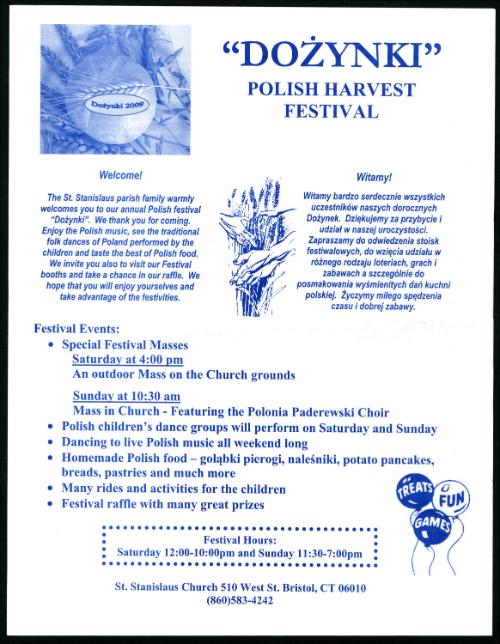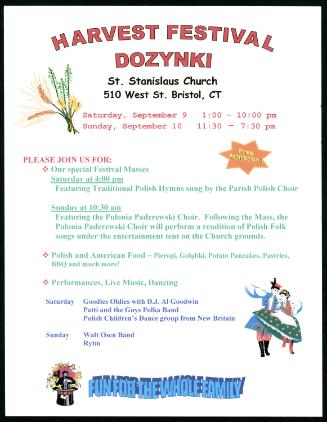Program: Dożynki Polish Harvest Festival
DistributorDistributed by
Saint Stanislaus Church
(founded 1919)
Date2009
MediumPaper
ClassificationsInformation Artifacts
Credit LineConnecticut Cultural Heritage Arts Program collections
CopyrightIn Copyright
Object number2015.196.60.7
DescriptionProgram for the Dożynki Polish Harvest Festival, St. Stanislaus Church, 2009.
NotesSubject Note: The Polish community comprises nearly 10% of the state’s population, settling here during the late 19th and early 20th centuries when New England’s industrial growth made jobs plentiful in mills and factories. Thousands from rural areas of Poland left behind difficult political and economic circumstances to work in America. A similar movement of people took place in the 1980s, and Polish newcomers continue to arrive, bringing a very different sense of “Polishness” and cultural tastes from the older immigrants. Uprooted from their homeland and all that is familiar, these new Americans have found refuge in maintaining traditional customs, beliefs, foods, language, and joining together in fraternal, cultural, political, academic, and veterans societies. Parish churches fill a very important function as centers for social organization and cultural unity as well as providing spiritual and emotional comfort. The Polish saying Co kraj, to obyczaj explains that in the American Polish communities called Polonia some of the old practices change to fit new circumstances, or disappear altogether among recent generations. The seasonal round of celebrations, festivals, holidays, along with the activities and art forms associated with them, connect Polish Americans to a dimension of beauty, meaning, spirituality, and heritage which they remember from the past but also practice today. In Connecticut works of art and everyday objects for use in the home are still made by hand in traditional Polish styles. Older objects from Poland are often redecorated with materials found here, and the process of creating and using these pieces shows an active expression of identity, not a mere recreation of old folk art forms.
New Britain, the center of Polonia in Connecticut, has a longstanding language school and folk dance group. Central Connecticut State University hosts the Polish and Polish American Studies Program and Library – one of only two such programs in the country. Broad Street is a thriving center of Polish commerce and activity, and has hosted an annual festival since 2012 called “Little Poland.” The festival is held in late April to mark Poland’s Constitution Day, a celebration of the democracy enjoyed by Americans under their country’s Constitution. In Hartford, the historically Polish neighborhood around Wyllys St/Popieluszko Court/Charter Oak Avenue included SS Cyril and Methodius Church, the Church School, the Polish National Home, and several businesses.
Community celebrations and seasonal holidays often follow the liturgical calendar of the Church. Christmas is celebrated with Pasterka, the midnight mass of the shepherds when koledy, holy carols, are sung. On the Feast of Epiphany, chalk is blessed in the church and used to inscribe door lintels with K + M + B, the initials of the three kings. At Easter, baskets of food for the Easter breakfast are blessed in the church. Processions mark Corpus Christi, the Feast of the Blessed Sacrament (and a ritual to ensure good crops) in June. In the late summer, harvest festivals called Dożynki featuring an open-air or church Mass with a blessing and distribution of bread, folk dancing, craft and food vendors are held in New Britain, Bristol, and Bridgeport/Ansonia. Harvest ornaments, large structures of wheat sheafs decorated with flowers and ribbons, are made and displayed by community artists. On All Souls Day in November Polish families visit the graves of their relatives, decorating them with candles and flowers after an outdoor mass.
Subject Note: Harvest festivals, Dożynki, were once common in the agricultural regions of Poland. The harvesting of grain for bread was crucial to survival, and many customs in rural Poland were designed to encourage a good crop. As with so many Polish celebrations, spiritual and secular worlds and concerns intertwine at this important time of year. Harvest time in late summer coincided with the religious Feast of the Assumption on August 15, celebrating the ascension of Mary into Heaven. On this feast day called Matka Boska Zielna, or Our Lady of the Herbs, women brought bouquets of herbs and flowers to the church to be blessed so that the healing powers of the plants would strengthen. At home they would place sprigs of herbs behind holy pictures on the wall. Flowers, herbs, and sheaves of wheat and rye were made into ornaments for dożynki celebrations. Some of these were large and heavy, symbolizing an abundant harvest, and some were shaped to suggest figures or topped with religious statues. Those involved in the harvest also fashioned dożynki wreaths in the shape of a crown out of grains, flowers, nuts, fruit, and ribbons. A young girl who had worked on the harvest would wear the wreath in procession to the house of the farmer, to whom the wreath would be presented.
In Connecticut several Polish American communities still hold dożynki festivals even though most people live and work in urban or suburban settings rather than on farms. The purpose of dożynki in Polonia is to reinstill an understanding of “Polishness” through using ceremony, music, and objects and values reminiscent of customs from Poland. For nineteen years New Britain has produced a festival featuring an open-air mass with a blessing and distribution of bread, folk dancing, craft and food vendors. Other communities holding annual harvest masses and festivals include Bristol’s St. Stanislaus Kostka Church and parish, and in Bridgeport/Ansonia at the White Eagle Social Club. Elaborate dożynki ornaments are still made and carried into the church during the festivals. While contemporary dożynki celebrations tend to be socials and parish fundraisers rather than agricultural rituals, they retain a strong sense of the way spirituality affects the daily lives of Polish Americans.
Additional audio, video, and/or photographic materials exist in the archive relating to this community and these events.
Cataloging Note: This project was made possible in part by the Institute of Museum and Library Services MA-245929-OMS-20.
Status
Not on viewSaint Stanislaus Church
2008 September 6
Saint John the Baptist Parish of the Polish National Catholic Church
1993
2000-2001 December-March
















